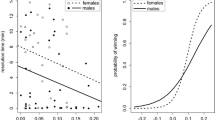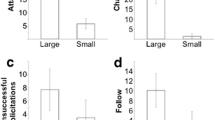Abstract
Selection imposed by male competition (intrasexual selection) and female choice (intersexual selection) can be con- or discordant. Specifically, females may or may not prefer mating with dominant males, and direct costs of interacting with dominant (and possibly more harassing) males have been suggested to explain avoidance of dominant males. Here, we exemplify that inter- and intrasexual selection may normally act in the same direction, but can be temporarily conflicting when social information becomes available. Using video playback techniques, we presented females of the Mexican livebearing fish Poecilia mexicana with two size-matched males and established association preferences. Half of the females could then observe the same two males fight and establish dominance, while control females saw both males side by side, but physically separated, and female preferences were subsequently re-evaluated. Females in the control group showed a significant preference for future winners in the subsequent testing, confirming an innate or acquired preference for male traits that are indicative of physical superiority, even when body size as a choice criterion is excluded. When allowed to eavesdrop on male fights, however, females did not show a preference for observed winners and even decreased time spent with them relative to the control treatment in which no fight was shown. A subsequent experiment found contest winners to show elevated levels of sexual behavior, so we argue that the temporary offset of the intrinsic female preference for dominant males after having observed a fight is indeed driven by direct costs females expect from more harassing contest winners.


Similar content being viewed by others
References
Andersson M (1994) Sexual selection. Princeton University Press, Princeton
Baker M, Bjerke T, Lampe H, Espmark Y (1986) Sexual response of female great tits to variation in size of males’ song repertoires. Am Nat 128:491
Beaugrand J, Goulet C, Payette D (1991) Outcome of dyadic conflict in male green swordtail fish, Xiphophorus helleri: effects of body size and prior dominance. Anim Behav 41:417–424
Berglund A, Bisazza A, Pilastro A (1996) Armaments and ornaments: an evolutionary explanation of traits of dual utility. Biol J Linn Soc 58:385–399
Bierbach D, Girndt A, Hamfler S, Klein M, Mucksch F, Penshorn M, Schwinn M, Zimmer C, Schlupp I, Streit B, Plath M (2011a) Male fish use prior knowledge about rivals to adjust their mate choice. Biol Lett 7:349–351
Bierbach D, Schulte M, Herrmann N, Tobler M, Stadler S, Jung CT, Kunkel B, Riesch R, Klaus S, Ziege M, Indy JR, Arias-Rodriguez L, Plath M (2011b) Predator-induced changes of female mating preferences: innate and experiential effects. BMC Evol Biol 11:190
Bierbach D, Klein M, Sassmannshausen V, Schlupp I, Riesch R, Parzefall J, Plath M (2012) Divergent evolution of male aggressive behaviour: another reproductive isolation mechanism in extremophile poeciliid fishes. Int J Evol Biol. doi:10.1155/2012/148745
Bishop PJ, Jennions MD, Passmore NI (1995) Chorus size and call intensity: female choice in the painted reed frog, Hyperolius marmoratus. Behaviour 132:721–731
Bonnie KE, Earley RL (2007) Expanding the scope for social information use. Anim Behav 74:171–181
Brewster J, Houde A (2003) Are female guppies more likely to flee when approached by two males? J Fish Biol 63:1056–1059
Candolin U (2004) Opposing selection on a sexually dimorphic trait through female choice and male competition in a water boatman. Evolution 58:1861–1864
Constantz G (1989) Reproductive biology of poeciliid fishes. In: Meffe G, Snelson F (eds) Ecology and evolution of livebearing fishes (Poeciliidae). Prentice Hall, Upper Saddle River, pp 33–50
Dabelsteen T (2005) Public, private or anonymous? Facilitating and countering eavesdropping. In: McGregor PK (ed) Animal communication networks. Cambridge University Press, Cambridge, pp 38–62
Doutrelant C, McGregor PK (2000) Eavesdropping and mate choice in female fighting fish. Behaviour 137:1655–1668
Dugatkin LA (1996) Copying and mate choice. In: Heyes CM, Galef BGJ (eds) Social learning in animals: the roots of culture. Academic Press, New York, pp 85–105
Earley RL (2010) Social eavesdropping and the evolution of conditional cooperation and cheating strategies. Philos T Roy Soc B 365:2675–2686
Earley RL, Dugatkin LA (2005) Fighting, mating and networking: pillars of poeciliid sociality. In: McGregor PK (ed) Animal communication networks. Cambridge University Press, Cambridge, pp 84–113
Fisher HS, Rosenthal GG (2007) Male swordtails court with an audience in mind. Biol Lett 3:5–7
Fitzsimmons LP, Foote JR, Ratcliffe LM, Mennill DJ (2008) Eavesdropping and communication networks revealed through playback and an acoustic location system. Behav Ecol 19:824–829
Gasparini C, Devigili A, Pilastro A (2012) Cross-generational effects of sexual harassment on female fitness in the guppy. Evolution 66:532–543
Goldstein JS (2001) War and gender: how gender shapes the war system and vice versa. Cambridge University Press, Cambridge
Hannes R-P, Franck D, Liemann F (1984) Effects of rank-order fights on whole-body and blood concentrations of androgens and corticosteroids in the male swordtail (Xiphophorus helleri). Z Tierpsychol 65:53–65
Howard RD, Martens RS, Innis SA, Drnevich JM, Hale J (1998) Mate choice and mate competition influence male body size in Japanese medaka. Anim Behav 55:1151–1163
Hunt J, Breuker CJ, Sadowski JA, Moore AJ (2009) Male–male competition, female mate choice and their interaction: determining total sexual selection. J Evol Biol 22:13–26
Köhler A, Hildenbrand P, Schleucher E, Riesch R, Arias-Rodriguez L, Streit B, Plath M (2011) Effects of male sexual harassment on female time budgets, feeding behavior, and metabolic rates in a tropical livebearing fish (Poecilia mexicana). Behav Ecol Sociobiol 65:1513–1523
Magurran AE (2011) Sexual coersion. In: Evans J, Pilastro A, Schlupp I (eds) Ecology and evolution of poeciliid fishes. University of Chicago Press, Chicago, pp 209–217
McCoy E, Syska N, Plath M, Schlupp I, Riesch R (2011) Mustached males in a tropical poeciliid fish: emerging female preference selects for a novel male trait. Behav Ecol Sociobiol 65:1437–1445
McGregor PK, Peake T (2000) Communication networks: social environments for receiving and signaling behaviour. Acta Ethol 2:71–81
Meisel RL, Sachs BD (1994) The physiology of male sexual behavior. In: Knobil E, Neill JD (eds) Physiology of reproduction, 2nd edn. Raven, New York, pp 3–106
Miller R, Minckley W, Norris S (2006) Freshwater fishes of Mexico. University of Chicago Press, Chicago
Monaghan EP, Glickman SE (1992) Hormones and aggressive behavior. In: Becker JB, Breedlove SM, Crews D (eds) Behavioral endocrinology. MIT, Cambridge, pp 261–286
Morris MR, Batra P, Ryan MJ (1992) Male–male competition and access to females in the swordtail Xiphophorus nigrensis. Copeia 1992:980–986
Morris M, Gass L, Ryan M (1995) Assessment and individual recognition of opponents in the pygmy swordtails Xiphophorus nigrensis and X. multilineatus. Behav Ecol Sociobiol 37:303–310
Naguib M, Amrhein V, Kunc HP (2004) Effects of territorial intrusions on eavesdropping neighbors: communication networks in nightingales. Behav Ecol 15:1011–1015
Ophir AG, Galef BG Jr (2003) Female Japanese quail that ‘eavesdrop’ on fighting males prefer losers to winners. Anim Behav 66:399–407
Padur L, Wedekind J, Öztürk Ö, Streit B, Tiedemann R, Plath M (2009) Do audience effects lead to relaxed male sexual harassment? Behaviour 146:1739–1758
Parzefall J (1969) Zur vergleichenden Ethologie verschiedener Mollienesia-Arten einschliesslich einer Höhlenform von M. sphenops. Behaviour 33:1–38
Peake TM (2005) Eavesdropping in communication networks. In: McGregor PK (ed) Animal communication networks. Cambridge University Press, Cambridge, pp 13–37
Plath M (2008) Male mating behavior and costs of sexual harassment for females in cavernicolous and extremophile populations of Atlantic mollies (Poecilia mexicana). Behaviour 145:73–98
Plath M, Tobler M (2007) Sex recognition in surface- and cave-dwelling Atlantic molly females (Poecilia mexicana, Poeciliidae, Teleostei): influence of visual and non-visual cues. Acta Ethol 10:81–88
Plath M, Seggel U, Burmeister H, Heubel KU, Schlupp I (2006) Choosy males from the underground: male mating preferences in surface- and cave-dwelling Atlantic mollies (Poecilia mexicana). Naturwissenschaften 93:103–109
Plath M, Makowicz AM, Schlupp I, Tobler M (2007) Sexual harassment in live-bearing fishes (Poeciliidae): comparing courting and noncourting species. Behav Ecol 18:680–688
Qvarnström A, Forsgren E (1998) Should females prefer dominant males? Trends Ecol Evol 13:498–501
Reichard M, Bryja J, Ondracková M, Dávidová M, Kaniewska P, Smith C (2005) Sexual selection for male dominance reduces opportunities for female mate choice in the European bitterling (Rhodeus sericeus). Mol Ecol 14:1533–1542
Riesch R, Schlupp I, Plath M (2008) Female sperm limitation in natural populations of a sexual/asexual mating complex (Poecilia latipinna, P. formosa). Biol Lett 4:266–269
Schlupp I, Plath M (2005) Male mate choice and sperm allocation in a sexual/asexual mating complex of Poecilia (Poeciliidae, Teleostei). Biol Lett 1:169–171
Tobler M, Plath M, Burmeister H, Schlupp I (2006) Black spots and female mating preferences in a sexual/asexual mating complex (Poecilia, Poeciliidae, Teleostei). Behav Ecol Sociobiol 60:159–165
Tobler M, Palacios M, Chapman LJ, Mitrofanov I, Bierbach D, Plath M, Arias-Rodriguez L, de Leon FJ, Mateos M (2011) Evolution in extreme environments: replicated phenotypic differentiation in livebearing fish inhabiting sulfidic springs. Evolution 65:2213–2228
Walling C, Royle N, Lindström J, Metcalfe N (2010) Do female association preferences predict the likelihood of reproduction? Behav Ecol Sociobiol 64:541–548
Watters JV (2005) Can the alternative male tactics ‘fighter’ and ‘sneaker’ be considered ‘coercer’ and ‘cooperator’ in coho salmon? Anim Behav 70:1055–1062
Westneat DF, Walters A, McCarthy TM, Hatch MI, Hein W (2000) Alternative mechanisms of nonindependent mate choice. Anim Behav 59:467–476
Witte K (2006) Learning and mate choice. In: Brown C, Laland KN, Krause J (eds) Fish cognition and behavior. Blackwell Publishing Ltd, Oxford, pp 70–95
Wong BBM, Candolin U (2005) How is female mate choice affected by male competition? Biol Rev 80:559–571
Acknowledgments
H. Geupel helped with animal care, and P. Slattery and R. Riesch kindly commented on previous manuscript drafts. The present study was financially supported by the research funding program “LOEWE—Landes-Offensive zur Entwicklung Wissenschaftlich-ökonomischer Exzellenz” of Hesse's Ministry of Higher Education, Research, and the Arts, the German Research Foundation (DFG; PL 470/3–1) and the Presidential Office of the J.W. Goethe University of Frankfurt (Nachwuchswissenschaftler im Fokus).
Ethical standards
The experiments reported here comply with the current laws of Germany (approved by Regierungspräsidium Darmstadt V-54-19c-20/15-F104/Anz.18).
Author information
Authors and Affiliations
Corresponding author
Additional information
Communicated by J. Frommen
Rights and permissions
About this article
Cite this article
Bierbach, D., Sassmannshausen, V., Streit, B. et al. Females prefer males with superior fighting abilities but avoid sexually harassing winners when eavesdropping on male fights. Behav Ecol Sociobiol 67, 675–683 (2013). https://doi.org/10.1007/s00265-013-1487-8
Received:
Revised:
Accepted:
Published:
Issue Date:
DOI: https://doi.org/10.1007/s00265-013-1487-8




